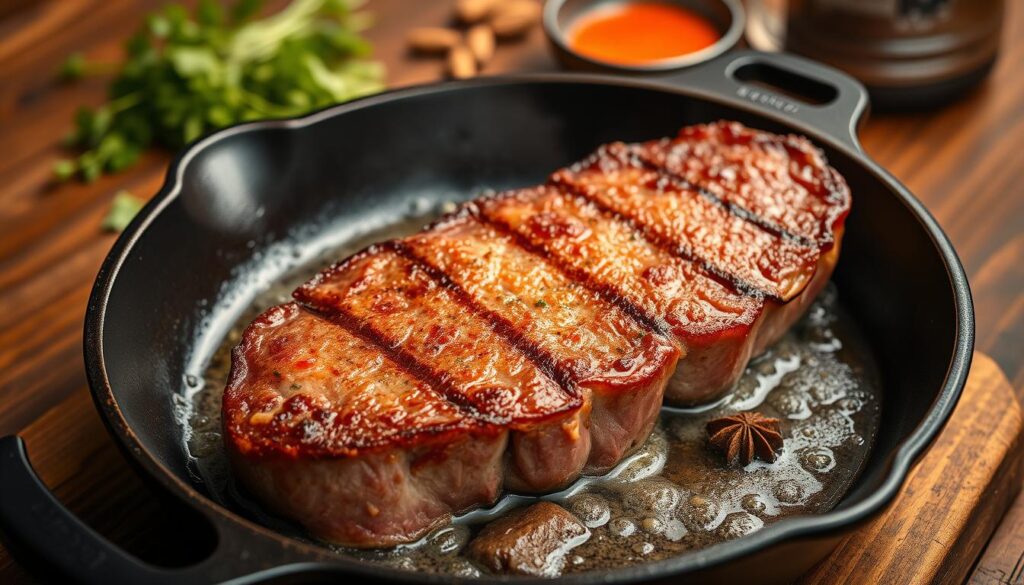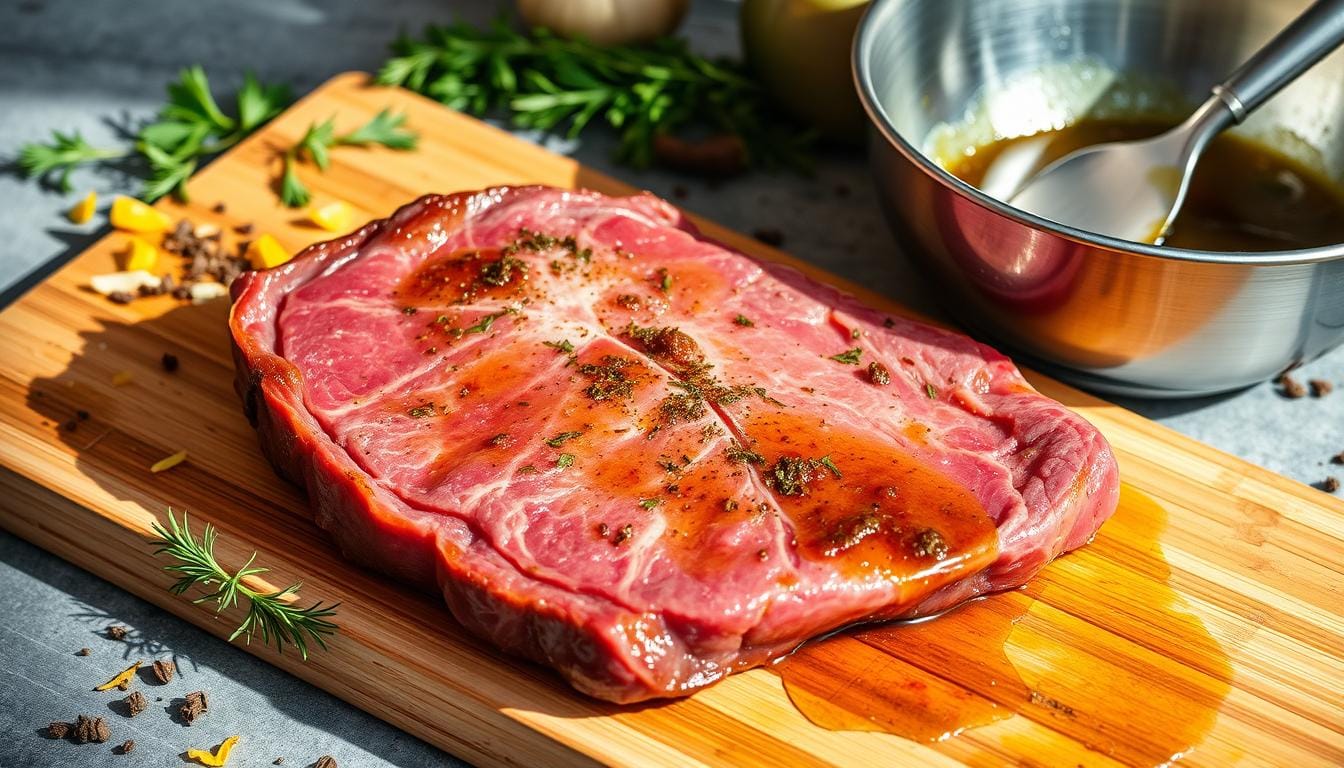Venison Tenderloin Marinade Tips for Perfect Results
Table of Contents
Growing up in a hunting family, I learned that venison tenderloin is more than just meat. It’s a culinary treasure waiting to be transformed. My grandfather’s careful preparation of a venison tenderloin marinade showed me it’s an art form passed down through generations.
Venison tenderloin is the best of wild game meat—it’s lean, delicate, and full of flavor. The right venison marinade can make this cut go from good to amazing. It turns a tough piece of meat into a tender, juicy dish.
Making the perfect venison tenderloin marinade means understanding deer meat. Unlike beef, venison needs a more careful approach to tenderizing and seasoning. This guide will show you how to make marinades that bring out the meat’s natural flavors.
Whether you’re a seasoned hunter or a curious home cook, learning to make a great venison marinade will change your wild game cooking. Get ready to discover the secrets of making delicious, perfectly seasoned venison that will wow even the pickiest eaters.
Understanding Venison Tenderloin vs. Backstrap
When you’re making a venison backstrap marinade, it’s key to know the difference between tenderloin and backstrap. These two parts of the deer meat are not the same. They have unique qualities that affect how you cook them.
Venison cuts are loved by hunters and chefs for their special qualities. Each part of the deer has its own texture and taste. You need to use the right cooking methods for each.
Location and Characteristics
- Tenderloin: Located inside the deer’s body cavity along the spine
- Backstrap: Runs along the exterior of the spine from the shoulder to the hindquarters
- Tenderloin is smaller and more delicate compared to the backstrap
Texture and Flavor Differences
| Cut | Texture | Flavor Intensity |
|---|---|---|
| Tenderloin | Extremely tender | Mild |
| Backstrap | Firm but tender | Rich |
Best Cooking Applications
Your marinade for venison backstrap will work differently for each cut. Tenderloin does well with quick, high-heat methods like grilling or pan-searing. Backstrap can handle a variety of cooking methods, including roasting and slow cooking.
Knowing these differences will help you make the perfect venison dish every time.
Essential Ingredients for a Perfect Venison Tenderloin Marinade
Making the perfect venison marinade turns a simple deer steak into a gourmet dish. The right mix of ingredients brings out the venison’s natural taste and makes it tender.
Your marinade needs acids, oils, and seasonings to be great. Each part is important for a tasty and tender meat.
- Acidic ingredients break down tough muscle fibers
- Oils help distribute flavors and retain moisture
- Seasonings enhance the meat’s natural taste
Key acidic parts for a deer steak marinade include:
| Acid Type | Flavor Profile | Tenderizing Power |
|---|---|---|
| Lemon Juice | Bright, Citrusy | High |
| Apple Cider Vinegar | Tangy, Subtle | Medium |
| Red Wine | Rich, Complex | Medium-High |
Choose extra virgin olive oil or avocado oil for your marinade. They add great flavor and keep the meat juicy.
Garlic, rosemary, thyme, and black pepper are top seasonings for venison. They boost the meat’s flavor without hiding its natural taste.
The Science Behind Marinating Game Meat
Marinating venison tenderloin is more than a cooking trick. It’s a science that turns game meat into a tender, tasty treat. Knowing the chemistry of venison tenderloin marinade can boost your cooking skills and make dishes that taste amazing.
Acid’s Magic in Meat Tenderization
Acidic ingredients are key in tenderizing game meat. When making a venison tenderloin marinade, ingredients like:
- Citrus juices
- Vinegar
- Wine
- Yogurt
Help break down muscle fibers. This creates tiny pockets for flavors to soak into the meat.
Perfecting Marinating Time
The length of marinating affects the meat’s texture and taste. For venison tenderloin, which is already tender, aim for:
- Marinating for 30 minutes to 2 hours
- Avoid over-marinating to prevent mushiness
- Keep marinades refrigerated
Short marinating times help keep the tenderloin’s delicate structure intact.
Temperature Considerations
Temperature control is key in marinating. Always marinate in the fridge at 40°F or below to stop bacterial growth. Before cooking, let your venison tenderloin rest at room temperature for 15-20 minutes. This ensures it cooks evenly.
Classic Citrus-Based Marinade Recipe

Making the perfect venison marinade can turn your deer steak into something special. A citrus-based marinade tenderizes and enhances the unique taste of venison. This makes your meal unforgettable.
The best venison marinade mixes acidity, oil, and spices. It should soften the meat and add rich flavors.
Essential Ingredients for Your Deer Steak Marinade
- 1/2 cup fresh lemon juice
- 1/4 cup olive oil
- 4 minced garlic cloves
- 2 tablespoons soy sauce
- 1 tablespoon Dijon mustard
- Fresh herbs (rosemary, thyme)
- Salt and black pepper to taste
Marinade Preparation Steps
- Whisk all ingredients in a non-reactive bowl
- Ensure thorough mixing of citrus and oil
- Place venison in a sealed container
- Pour the marinade over the meat
- Refrigerate for 2-4 hours
The lemon juice in this marinade tenderizes the venison. Pro tip: Never marinate venison longer than 4 hours, as the acid can start to chemically “cook” the meat.
| Ingredient | Purpose | Quantity |
|---|---|---|
| Lemon Juice | Tenderize meat | 1/2 cup |
| Olive Oil | Moisture retention | 1/4 cup |
| Garlic | Flavor enhancement | 4 cloves |
| Soy Sauce | Umami depth | 2 tablespoons |
Your homemade venison marinade will make your deer steak exceptional. It brings out the meat’s natural richness and ensures a tender, flavorful dish.
Preparation Steps Before Marinating
Getting your venison tenderloin ready for a delicious marinade requires careful preparation. The right approach can transform your game meat from tough to tender. This ensures a mouthwatering dining experience.
Trimming for Maximum Flavor
Before applying your venison tenderloin marinade, proper trimming is key. Silver skin can block marinades from getting into the meat. Use a sharp boning knife to remove:
- Silvery membrane covering the meat
- Excess fat or connective tissue
- Any visible discolored or damaged sections
Sizing and Cutting Considerations
The size of your venison tenderloin affects marinating time and cooking results. Aim for uniform pieces that are:
- Approximately 1-2 inches thick
- Trimmed to consistent lengths
- Free from irregular edges
“Perfect preparation is the secret to an exceptional venison tenderloin marinade.” – Wild Game Chef
Temperature Management
Temperature is key in preparing your venison tenderloin. After trimming, let the meat rest at room temperature for 30-45 minutes before marinating. This helps the meat absorb flavors more evenly and ensures more consistent cooking.
Always marinate venison in the refrigerator to prevent bacterial growth. Use a sealed container or zip-lock bag to maximize flavor absorption while maintaining food safety.
Best Cooking Methods for Marinated Tenderloin

Cooking a perfect deer steak in the oven needs precision. You must understand venison tenderloin’s unique traits. The cooking method greatly affects the meat’s tenderness and taste.
When making your venison tenderloin marinade, keep these top cooking techniques in mind:
- Grilling: High heat creates a delicious crust while keeping the inside moist
- Pan-Searing: Quick, intense heat seals in juices and adds rich flavors
- Oven Roasting: Offers even cooking for consistent results
- Smoking: Delivers complex flavors at lower temperatures
For the best deer steak in the oven, follow these key guidelines:
- Preheat your oven to 375°F
- Remove tenderloin from the marinade and pat dry
- Sear meat in a hot skillet for 2-3 minutes per side
- Transfer to the oven and cook until the internal temperature reaches 130-135°F
- Rest the meat for 10 minutes before slicing
Pro tip: Never overcook venison tenderloin, as it can quickly become tough and dry.
Your venison tenderloin marinade will shine with the right cooking methods. Quick, high-heat techniques preserve its natural tenderness. They also enhance its rich, wild flavor.
Temperature Control and Cooking Times
Cooking deer steak in the oven needs precision and knowing how to control the temperature. Your marinade is just the start. The real magic happens in the cooking process.
Getting the venison just right is all about the internal temperature. It’s key to keeping the meat tender and full of flavor. Chefs always use a meat thermometer for the best results.
Internal Temperature Guide
Here’s what to aim for when cooking your venison tenderloin:
- Rare: 120-125°F
- Medium-Rare: 130-140°F (Recommended)
- Medium: 140-150°F
- Well-Done: 160°F and above (Not recommended for venison)
The Importance of Resting
After cooking, let your venison rest for 10-15 minutes. This step is vital. It lets the juices spread out, making the meat more tender and flavorful.
Pro Tip: Wrap the cooked venison tenderloin loosely with foil during the resting period to maintain its temperature without continuing to cook.
Your marinade and careful temperature control will make your venison tenderloin taste like it’s from a fancy restaurant. It’s a lean, delicious meat that’s worth the effort.
Common Marinating Mistakes to Avoid
Getting your venison marinade right is all about the details. Many home cooks make mistakes that ruin their venison tenderloin marinade. This turns a promising meal into a letdown.
Here are some common mistakes to steer clear of when making your venison marinade:
- Over-Marinating: Don’t leave venison in the marinade for too long. It can become mushy. Stick to marinating times of 4-8 hours for the best results.
- Reusing Marinades: Never use marinades that have come into contact with raw meat. This can spread harmful bacteria and risk food safety.
- Incorrect Container Choice: Don’t use metal containers for marinating. Acidic ingredients in your marinade can react with metal, causing bad flavors.
Keeping the temperature right is key when marinating venison tenderloin. Always marinate in the fridge, not at room temperature. This stops bacteria from growing and lets flavors soak into the meat well.
Before cooking, dry your marinated venison tenderloin with paper towels. This step helps get a great sear and stops steaming. Steaming can make the meat less flavorful.
Pro tip: Quality is more important than quantity when it comes to venison marinade. A well-balanced marinade applied with care can make your game meat amazing.
Avoiding these common mistakes will take your venison tenderloin from good to amazing. You’ll ensure a memorable dining experience every time.
Flavor Enhancement Techniques
To make your deer steak marinade amazing, learn about flavor layering. The right mix of herbs, spices, and liquids can turn your venison tenderloin into a dish that wows everyone.
Making a great venison marinade means picking the right ingredients. You want to boost the meat’s flavor and add depth.
Herb and Spice Combinations
Choose herbs that make venison taste even better. Here are some great options:
- Rosemary adds earthy, pine-like notes
- Thyme – provides subtle, aromatic undertones
- Sage – introduces a robust, peppery flavor
- Juniper berries bring a wild, forest-inspired essence
Wine and Alternative Liquid Enhancements
Liquids are key in a memorable deer steak marinade. Try these to boost flavor:
- Red wine adds rich, complex undertones
- Apple cider introduces a subtle sweetness
- Dark beer – provides depth and caramelized notes
- Balsamic vinegar – contributes tangy complexity
When making your venison marinade, remember to balance. Mix ingredients that enhance the meat’s flavor without overwhelming it. A well-made marinade can elevate your venison from ordinary to extraordinary.
Storage and Food Safety Tips
Storing your venison marinade right is key to keeping food safe and the meat tasting great. When you’re working with a venison tenderloin marinade, follow important steps. These steps help avoid foodborne illnesses and make sure your meal is the best it can be.
Refrigeration is your main line of defense for storing marinated venison. You need to handle the marinade carefully to keep the meat safe and flavorful. Always put marinated venison in a sealed container and keep it at or below 40°F (4°C).
- Refrigerate marinated venison right after you make it
- Use the marinated meat within 24-48 hours
- Don’t let venison marinade sit at room temperature for more than 2 hours
When you’re preparing venison tenderloin marinade, watch out for cross-contamination. Use different cutting boards and tools for raw meat to stop bacteria from spreading. Clean all surfaces well with hot, soapy water after you’ve worked with the meat.
Handling marinade safely is also very important. Never use a marinade that has come into contact with raw venison. If you want to use the marinade as a sauce, save some before adding raw meat. Or, boil the used marinade for at least one minute to kill bacteria.
- Throw away the marinade that has touched raw meat
- Make a separate basting sauce if you want
- Boil the marinade to make a safe sauce
Thawing venison tenderloin marinade safely is also a must. Always thaw frozen venison in the fridge, not at room temperature. This slow thawing keeps the meat safe from bacteria.
Conclusion
Making the perfect venison tenderloin marinade is like a work of art. It turns lean game meat into a dish that’s truly special. By mastering the art of marination, you can make your venison stand out.
Choosing the right ingredients is key. You also need to be gentle with the meat. This way, you can bring out its best flavors.
Getting ready for your venison dish is important. From trimming to seasoning, every step matters. Trying out different marinades lets you find the perfect taste for you.
Remember, food safety and cooking techniques are essential. The marinades not only add flavor but also make the meat tender. This ensures a great meal every time.
Now, it’s time to try these marinade skills in your kitchen. Share your cooking stories and keep learning. Your journey to becoming a venison expert begins today.
FAQ
How long should I marinate venison tenderloin?
What are the best ingredients for a venison tenderloin marinade?
What is the recommended internal temperature for cooking venison tenderloin?
Can I reuse marinade that has been in contact with raw venison?
How do I prevent venison tenderloin from becoming tough?
What’s the difference between venison tenderloin and backstrap?
Can I freeze marinated venison tenderloin?
Did You Try Our Recipe?
There are no reviews yet. Be the first one to write one.

